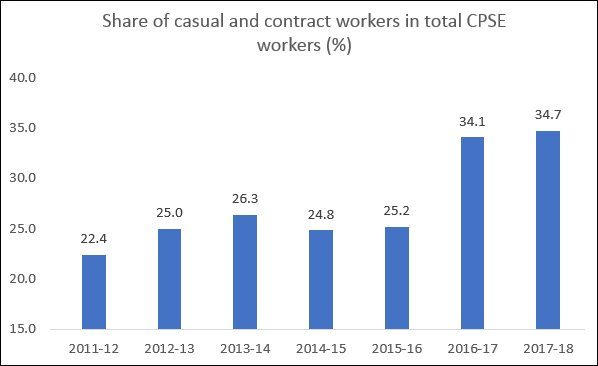The aim of all fascistic governments is to disempower the people; and the Modi government…
India’s withering Public Employment C. P. Chandrasekhar and Jayati Ghosh
While the neoliberal focus has been on attempts to “shrink the state” on the grounds of corruption and inefficiency, sensible people have long recognised that high levels of public employment tend to be associated with better quality of life for people in a society. After all, the essential public services, from infrastructure to amenities, to security to social services, mostly have to be delivered by governments. This is because private markets simply do not provide them or underprovide them, and also because private provision, based on profitability, delivers much more unequal results. And delivering all this necessarily requires employing people.
Because of this, it is possible to argue that the extent of public employment can be a useful indicator of the coverage and quality of public services in a country. By this marker, unsurprisingly, Scandinavian countries (known also to be among the most equal societies in the world) have the largest extent of public employment. But what is also remarkable is just how low India’s public employment is by international standards. Figure 1 shows that, relative to population, public employment in India is only one-tenth of that in Norway, only 15 per cent of that in Brazil and much less than a third of that in China. Clearly, India is hugely underproviding public services, and it is therefore no surprise that so many people remain excluded from the essential public services that ensure quality of life, or receive such services only very partially and inadequately.
Figure 1: India’s public employment is low by international standards

Sources: European countries: www.europeandatajournalism.eu; Brazil and China:
calculated from World Bank data on public employment and UN population projections;
United States and India: Report of Seventh Pay Commission of India, 2016
It is not only that such employment (and the number of public jobs) is absolutely low, therefore indicating that both coverage and quality of public services is grossly inadequate. It is also that the governments at both central and state levels have been very poor even in filling the vacancies in existing posts, so that despite some increase in sanctioned posts, the absolute number of those employed has barely budged over time despite increasing population, as Figure 2 indicates. As a result, in 2014, nearly 7.5 lakh positions were lying vacant in the central government alone, amounting to almost one in five of all sanctioned positions.
Figure 2: Vacancies in central government employment have gone up

Source: Report of Seventh Pay Commission of India, Government of India
Central government employment is estimated to constitute only around 14 per cent of total public employment in India, the remainder being with the state governments that are largely responsible for public security and social services. We do not have estimates for the vacancies across all state governments, but even assuming that a similar ratio of vacant posts holds for them in the aggregate, that would amount to 38.8 lakh vacant posts in 2014! Since then, indications are that such vacancies have only increased.
Simply filling the vacancies would go some way towards addressing the current employment crisis in India; it would also mean much more extensive and better quality delivery of public services, because most such services cannot be delivered without people. The results of these gaps are only too evident. Stories abound across the country: of schools catering to several hundred children having only 3 or 4 teachers; of villages that are simply not served by agricultural extension officers; of health facilities that do not have adequate numbers of doctors and nurses; and so on.
However, instead of trying to ensure that all vacant posts are filled, both central and state governments appear to have further reduced the number of those in employment. An examination of the total employment in central public sector enterprises (CPSEs) provides a telling example. Figure 3 shows the trend. Even in the period between 2011-12 and 2017-18, employment in CPSEs fell by as much as 2.2 lakhs in total. What is more, the biggest declines in such employment were not at the managerial and supervisory levels, because such employment remained mostly stable with only minor declines, but among “non-executive” workers of all kinds. In other word, fewer actual workers were being handled by relatively more managers and supervisors.
Figure 3: Employment in Central Public Sector Enterprises has fallen

Even worse, among such “non-executive” workers, the proportion that are under contract or casual/daily work has increased significantly, as shown in Figure 4. By 2017-18, such insecure workers accounted for more than one-third of the actual workforce. Less secure contracts and deteriorating conditions of work obviously spell bad news for the workers involved, but they also have implications for the workings of such enterprises and for long-run productivity gains, because the advantages of learning by doing are less likely to be realised.
Figure 4: More casual and contract workers in the CPSEs

It is not clear whether the central government’s niggardly attitude towards public employment results from ideological predilection or is rather a ham-handed attempt to deal with the fiscal mess it is undoubtedly in. It is true that simply leaving posts vacant saves the government some money by reducing the potential wage bill. But that is not just short-sighted strategy; it is also deeply irresponsible and unjust, because it deprives people of the goods and services the government should be providing, lowers the quality of such delivery, and also reduces the level of employment that could be generated (directly and through multiplier effects) if all the posts were filled and if the posts were expanded to fill the clear needs.
In a functioning democracy, the political process would be one that would force the government to provide such necessary employment. Sadly, that does not seem to be the situation in India at present.
(This article was originally published in the Business Line on July 29, 2019)
